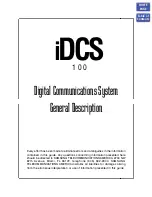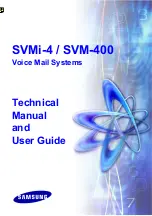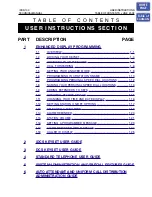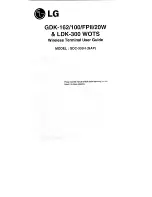
5
Guidelines for Safe and Efficient Use
Important: Read This Information
Before Using Your 9p23 Portable
Telephone
The handheld portable wireless telephone
is one of the most innovative products
ever developed. With it, you can
maintain connectivity to traditional
telephone services while remaining mobile
around hospital, campus or office. For
the safe and efficient operation of your
phone, observe the guidelines in this
manual. Your wireless telephone is a radio
transmitter and receiver. When it is ON
it receives and sends out radio frequency
(RF) energy. The phone operates in the
frequency range of 1920 to 1930 MHz
and employs commonly used modulation
techniques.
Exposure to Radio Frequency Signals
(SAR)
Your wireless phone is a radio transmitter
and receiver. It is designed and manufac-
tured not to exceed the emission limit for
exposure to radio frequency (RF) energy
set by the Federal Communications
Commission of the U.S. Government and
Canada. These limits are part of compre-
hensive guidelines and established
permitted levels of RF energy for the
general population. These guidelines are
based on the safety standards previously
set by both U.S. and international
standards bodies.
These standards include a substantial
safety margin designed to assure the safety
of all persons, regardless of age and
health.
The exposure standards for wireless
mobile phones employs a unit of measure
known as the Specific Absorption Rate, or
SAR. The SAR limit set by the FCC and
Canada is 1.6W/kg averaged over one
gram of tissue.
Guidelines for Safe and Efficient Use
Tests for SAR are conducted using
standard operating positions specified by
the FCC with the phone transmitting at
its highest certified power level in all
tested frequency bands. Although the SAR
is determined at the highest certified
power level, the actual SAR level of the
phone while operating can be well below
the maximum value. This is because the
phone is designed to operate at multiple
power levels.
Before a phone model is available for sale
to the public, it must be tested and
certified to the FCC that it does not
exceed the limit established by govern-
ment-adopted requirement for safe
exposure. The tests are performed in
positions and locations(for example, at
the ear and worn on the body) as required
by the FCC for each model. The highest
SAR value for this phone when tested for
use at the ear is 0.076 W/kg, and when
worn on the body is 0.018 W/kg. (Body
worn measurements differ among phones
depending upon available accessories and
the FCC requirements.) While there may
be differences between the SAR levels of
various phones and at various positions,
they all meet the government require-
ment for safe exposure.
For body worn operation, to maintain
compliance with FCC RF exposure
guidelines, use only Ascom approved
accessories. When carrying the phone
while it is on, use only the specific Ascom
belt clip that has been tested for
compliance.
Use of non-Ascom-approved accessories
may violate the FCC RF exposure
guidelines and should be avoided.
The FCC has granted an equipment
authorization for this Ascom 9P23 phone
with all reported SAR levels evaluated as
in compliance with the FCC RF emissions






































